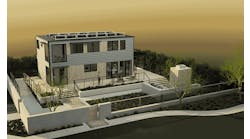Good Microgrids Make Good Neighbors: EcoBlock Seeks Model Way to Share Energy
As a neighborhood microgrid forms in Oakland, California, project planners find themselves grappling with a question unique to the age of local energy: How will neighbors cooperate with one another to share electricity?
Being developed by a team from the University of California, Berkeley, the Oakland EcoBlock Project aims to provide an oasis of resiliency during utility outages and a decarbonization model for neighborhoods nationwide. The project is especially timely as California grapples with widespread outages to avert wildfires.
Most microgrids, so far, have been built for campuses or at businesses, not neighborhoods. So the team is forging into new terrain as it develops its model for a neighborhood microgrid, one that encompasses a residential city block. The project, expected to take four years, won a $1.5 million grant from the California Energy Commission (CEC) for the first phase, its design and development, and recently received an additional $5 million from the CEC for the second phase, which includes bidding, construction, commissioning, and post occupancy evaluation.
Alexandra von Meier, an adjunct professor in the department of electrical engineering and computer science, is hoping to identify a simple organizational model that’s not subject to regulation. The overall goal is to create a neighborhood organization that can serve as a blueprint for similar EcoBlock projects.
“This project could transform an obsolete, resource-wasteful energy model into an integrated design that guarantees long-term energy sustainability while providing a replicable, scalable model,” said the CEC in a report.
The team is focusing on a neighborhood located in Oakland’s Golden Gate neighborhood, in the northwest corner of the city.
Access and bounds
Located behind the meter, the neighborhood microgrid will include solar and storage, sized to allow the residents to go off grid for several days. Older homes will be retrofitted for the project.
Just as important as the technology of the system is the organization of the neighbors.
“What will the metering and tariff arrangements inside the EcoBlock look like? On a good day there will be enough power to go around. But what happens, for example, during an outage if there isn’t enough power for all the residents involved? The neighbors will have to identify their essential and non-essential electricity needs. Can they do this by themselves, without some kind of governing body?” said von Meier, who is also director of electric grid research at the California Institute for Energy and Environment.
“We as a university want to help residents on the block self organize,” she said. “We’re hoping another block could follow the same recipe without having to hire a team of lawyers.”
“With the power shutoffs, it got tangible and real for people” — von Meier
A minimum set of rules should be put in place to ensure that neighbors have equal access to the electricity, she said. A system for deciding how to share costs and revenues should be established. But it’s still unclear how that will be accomplished. An organization similar to a cooperative or mini municipal utility is one possibility, as long as it’s not regulated.
The organization would coordinate how neighbors would pay for and share the EcoBlock resources. They include solar panels on each home that are connected to the microgrid.
“There will be just one point of common coupling with the microgrid behind it,” von Meier explained. Net metering won’t be part of the scheme. The solar and storage will be shared among the residents.
There will be a DC bus that connects PV systems on different rooftops.
Relationship with utility
While the microgrid will be connected to Pacific Gas & Electric (PG&E), the goal is to use the utility not as a primary source of power, but as a backup to the microgrid. And not all household systems will necessarily be served by the utility. Some of the home appliances, for example, will be powered solely by the microgrid, she said.
“We are switching over customers’ space and hot water heating and replacing them with DC appliances powered by the microgrid,” she said.
The project is looking at the possibility of the microgrid helping integrate solar and electric vehicles (EV) at the distribution level.
“The idea for meeting climate goals is to transition to electric, which adds demand on the system,” von Meier explained. “We want this to be a resource for PG&E and take the burden off the utility for managing solar integration and EV charging.”
The EcoBlock could use solar generation to neutralize the impact of growth in EV charging.
Making a neighborhood microgrid affordable
The team also would like the neighborhood microgrid to generate income by providing grid services, including voltage regulation, demand side resources and frequency regulation resources, once California creates clear payment rules for microgrids to do so.
“The idea is, yes it can be recruited for grid services as long as there are the right tariffs in place,” she said.
Image Courtesy UC Berkeley
It’s possible the savings generated by the solar, storage and new appliances will yield enough money to pay for the capital expenses of the neighborhood microgrid, said von Meier.
“We have done some analysis and see it’s feasible to finance it with savings,” she said. “We’re trying to plan for a future where this is routine. We hope to retrofit a block and hope it won’t break the bank.”
Why city blocks?
The project focuses on retrofitting city blocks because they are common units of organizing homes in urban and suburban America. EcoBlock notes on its website that 80.7% of the U.S. population lives in urban areas and 40% of US GHG greenhouse gases emanate from buildings. Homes account for 53% of the building count.
By retrofitting city blocks — which generally have moderate to high population density — the team hopes to make clean technology more affordable. They also are testing the hypothesis that block-scale energy retrofits are more efficient than home-scale retrofits.
California power shutoffs heighten need
The recent public safety power shut offs by PG&E have shed light on the advantages of the EcoBlock model.
“People have a whole new perspective on what’s it’s worth to have reliable power. It’s hitting people that power outages of long duration are possible,” said von Meier. “Before it was an abstract and remote possibility. With the power shutoffs, it got tangible and real for people.”
Learn more about neighborhood microgrid projects and other innovations in local energy. Subscribe to the free Microgrid Knowledge newsletter.








